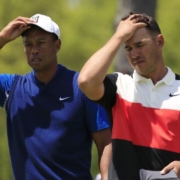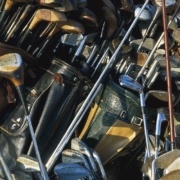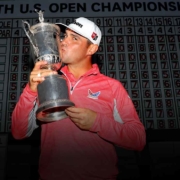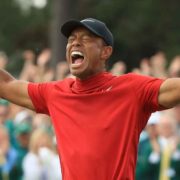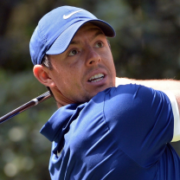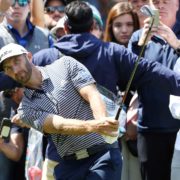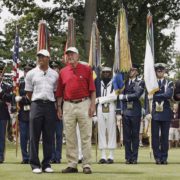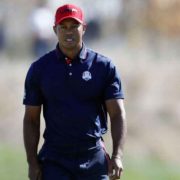Major questions about Tiger Woods, Brooks Koepka and more with Masters one month away
It’s hard to believe it has nearly been 365 days since Tiger Woods stunned the golf world by winning his fifth green jacket at the Masters.
The 84th edition of the Masters, the first major championship of the PGA Tour season, is only one month away.
There’s much uncertainty, starting with the defending champion. Woods’ aching back, which was a question mark a year ago, is once again a concern. So is Brooks Koepka’s game after knee surgery, and the uncertainty surrounding the coronavirus outbreak.
Here’s everything you need to know 30 days from the 2020 Masters:
Uncertainty and Tiger Woods
The Masters is only one month away, and defending champion Tiger Woodshasn’t played competitive golf in nearly as long.
Woods, 44, will skip the Players Championship this week after missing the WGC-Mexico Championship and Arnold Palmer Invitational, as well. He complained of back stiffness in mid-February at the Genesis Invitational in Los Angeles, where he finished last among players who made the cut.
His agent, Mark Steinberg, told ESPN in a text message on Friday that Woods’ back is “not concerning long term, just not ready.”
In a Twitter post on Friday, Woods wrote: “I have to listen to my body and properly rest when needed. My back is simply just not ready for play next week. I’m sad to miss one of the best events of the season, OUR championship.”
So what’s next for the 15-time majors champion? Even if his back is ready, will his game be ready if he can’t play in the upcoming Valspar Championship or WGC-Dell Technologies Match Play Championship?
It’s hard to imagine Woods not being back at Augusta National on April 9-12 to defend his Masters title. A year ago, he captivated the world when he came from behind to win there, after waiting 14 years to win his fifth green jacket. He became the second-oldest man to win the Masters, at 43 years, 3 months and 15 days old.
Another win at Augusta this year would tie him with Jack Nicklaus for the most Masters victories with six.
“It’s been incredible for myself and my family to be a part of this and for me to be the current Masters champion,” Woods told reporters in a teleconference last month. “It’s crazy that somehow it all came together for one week, one magical week.”
As magical as those 72 holes were a year ago, golf fans were also left wondering whether Sunday at Augusta in 2019 was a fitting end and the final crowning achievement to golf’s most legendary career.
After four back surgeries and another knee surgery in August, would Woods’ body allow him to continue contending at major championships? After winning the Masters, he missed cuts at the PGA Championship and Open Championship and withdrew from the Northern Trust.
After his fourth knee surgery, he unexpectedly won the Zozo Championship in Japan in October and went 3-0 at the Presidents Cup in December. He tied for ninth at the Farmers Insurance Open in his first event of 2020, and everything seemed fine until he suffered back stiffness at the Genesis.
While downplaying the injury at the Genesis, Woods said his plan was “to peak around Augusta time.”
Augusta time is almost here, and there are still plenty of questions when it comes to Woods.
Can Brooks Koepka find his game?
Woods isn’t the only golfer with big questions only a month from the Masters. Koepka, who only a year ago became the first player to hold back-to-back titles in two majors (PGA Championship and U.S. Open) simultaneously, all of the sudden can’t crack the top 40 at a tournament.
Koepka, who played with a painful knee injury for much of last season, hasn’t done much of anything since the end of the 2018-19 season. He missed the cut at the Shriners, withdrew from the CJ Cup, tied for 43rd at the Genesis and then missed the cut at the Honda Classic.
This past weekend, he carded a career-worst 9-over 81 in the third round of the Arnold Palmer Invitational (followed by a 71 on Sunday). He finished 9 over, good for a tie for 47th.
“Still s—. Still s—. Putting better,” Koepka told reporters on Sunday at Bay Hill.
Koepka said he feels better about his putting, but his swing is still too inconsistent.
Koepka, 29, plans to play five straight weeks, with upcoming starts at the Players Championship, Valspar Championship and WGC-Dell Technologies Match Play, before taking a week off before the Masters.
“To tell you the truth, I mean, I would never play more than three weeks in a row,” Koepka said. “But, obviously, sometimes things happen, and the only way I see getting through this is playing. That’s my way of trying to grind and work it out and figure it out.
“I mean, every year we have come — I don’t know how far back, to 2016 — all the way through the Match Play has been terrible. So I don’t know what it is about these first three months of the year, but I struggle quite a bit.”
Coronavirus status
Could you imagine a Masters without thousands of patrons surrounding the greens and lining the fairways of Augusta National Golf Club?
Hopefully, it won’t come to that, but Augusta National officials are monitoring the coronavirus outbreak and consulting the World Health Organization, Centers for Disease Control, Georgia Department of Public Health and other local authorities.
In a memo released by Augusta National chairman Fred Ridley last week, the club said the “safety, health and well-being of everyone is our top priority.”
“As a result of this collaboration, and based upon our knowledge of the situation at this time, we are proceeding as scheduled for the Augusta National Women’s Amateur, the Drive, Chip and Putt National Finals and the Masters Tournament,” the letter said. “We will continue to review the available facts and information with the experts and authorities, establish precautions and take appropriate action to ensure the safety of all involved.”
The Augusta National Women’s Amateur is scheduled for April 1-4, and the Drive, Chip and Putt National Finals are set for April 5.
Golf equipment truths: How often should you replace your irons?
We are lucky to have two of the most knowledgable golf gearheads in our office. And they are sharing their knowledge with you. Golf Digest’s equipment editors, Mike Stachura and E. Michael Johnson, have covered the golf equipment business for decades, and there are few who know the equipment industry better. We’ve asked them to answer your questions in a weekly equipment round-up. Tweet them any equipment questions you have, and they might answer your questions next week.
How often should you replace your irons? Mine are approximately 10 years old, but I only play twice a month. How much life is left in them? They are TaylorMade Burner 2.0. @doak_liam
Let us start with how much life is left them. Golf clubs have a very long life. It takes a lot to bust a club, and there are plenty of people playing irons that are 10 years old. So it’s not like they’re about to disintegrate in your hands at impact. But fact is if you’re not swapping out your irons at least every five years you’re leaving a fair amount of improvement on the table. At 10 years, well, it’s like handing your opponent in a $5 nassau an extra stroke a side. Today’s irons compared to your current ones are faster and considerably more forgiving. Shafts—even stock shafts—have gotten better, too. And if you don’t feel like ponying up full boat for a new set, try a used-club outlet such as the U-Try program at GlobalGolf and consider a set that’s only two or three years old. At least that’s an upgrade from what you’re currently playing. Oh, and twice a month isn’t something we’d use the word “only” with. That’s 24 times a year, my friend. That’s worthy of having some more current irons.
In raising a kid in golf, should our kids be trying to drive the ball 350 yards or should they be content with having a complete game? –@DavidBHooten
Short answer: Yes. Now, unless you’re trying to raise the next Kyle Berkshire (the reigning world long-drive champ), we think there’s more to this answer than how far your youngster needs to hit the ball. Distance off the tee is a tremendous advantage in golf. Distance off the tee without a solid iron game, superior short game and reliable putting stroke is nearly useless. After all, even Happy Gilmore had to learn how to putt. Focus on a complete game. If the individual has the potential to hit the ball that far, a good instructor will unleash that potential along with everything else. Just ask Rory McIlroy or Dustin Johnson. Plus a complete game lasts a lot longer. Not many guys in their 50s and 60s are bombing it 350. That said, we know college coaches who tell us that if they see a kid who’s not generating 170 miles per hour of ball speed, they quietly whisper to themselves, “Better practice folding those quarter-zip pullovers.” If you’re going to compete at the highest level, you need that extra gear. In the first two events this year, there were 263 drives of 350 yards or more. Last year 201 players recorded a drive of 350 yards or more on the PGA Tour, or about 50 more than kept their playing privileges. Even Matt Kuchar, Stewart Cink and Lucas Glover had 350-yard drives. On the Korn Ferry Tour last year, there were 271 players who hit at least one drive 350 yards. Less than 10 percent of those gentlemen were good enough to get to the PGA Tour. just like there aren’t that many 225-pound left tackles in the NFL anymore, physicality is a factor. And while not many Corey Pavins are making it all the way to the Big Show anymore, if you want to get there, it helps immeasurably if you have his resourcefulness, his will, his hands and his tenacity. Indeed, of the top 30 in the FedEx Cup regular season last year, only 15 averaged more than 300 yards off the tee (admittedly, seven of the top 10), and five (Kuchar, Webb Simpson, Kevin Kisner, Francesco Molinari and Chez Reavie—all of whom won tour events) averaged less than 290. How retro. Of course, if we’re talking about your daughter, that’s a different story. She doesn’t need to hit it 350. Yet.
I’m buying a set of Callaway Epic Flash Woods online. How can I tell if they are authentic? –@duntagolfer
Thrilled you ask this question because this is really important. First, “buying online” can mean a lot of things. (Truthfully, it’s a bit like searching for a mail order bride, rife with uncertainty and deceit and occasional serendipity. There’s a lot to unpack there.) There’s buying online from Golf Galaxy or PGA Tour Superstore or any number of highly reputable retailers. Then there’s buying off eBay or similar sites. If the latter, here’s some advice. The internet is a haven for counterfeiters. It offers them a wide audience of people who are willing to buy on faith. Not that you can’t find legit product, but you need some safeguards. First, look at the photo and the seller profile. If the seller is offering multiples of the same item and the photos all look like a glam shot, that’s a sign it could be iffy, especially with a newer model such as Epic Flash. It’s not often someone is trying to dump current models at a steep discount. But let’s say you’ve purchased the club and aren’t sure. Here are some things you can do afterward to see if you’ve been hornswoggled: Check the font of the logo. Counterfeits are often slightly off (usually thicker). On a club like the Epic Flash driver, tap a coin on the crown. If it rings like the Liberty Bell you’ve been had—that crown should be carbon and it will only ring if it’s titanium. And, believe it or not, you can smell the grip. Counterfeiters use very cheap rubber, and it has a distinct, pungent smell to it. But best to simply stick to Rule No. 1: If it’s not purchased from an authorized dealer, the risk isn’t worth it. Be honest, not cheap. You’re worth it.
I recently got fitted and spent $400 on a putter. After a few rounds I went back to a 35-year-old Ping Anser 3. –@jamejonson
No one is in favor of modern technology more than us. But we’re golfers, too, and understand the confidence that sometimes comes from a familiar look on the greens. In fact, one of us (not @MikeStachura) is currently rolling it with a Never Compromise GM2 Exchange circa 2007 with a grip that’s about to fall to pieces. So we get it. All that said, don’t put that $400 flat stick up on eBay just yet. We love the fact you got fitted for your putter, and that has to pay off at some point. There’s also no reason your 35-year-old putter can’t be measured and tweaked to make sure it fits you and your current stroke. Then you have options. A good fitting doesn’t mandate you buy something new, but rather simply fix something old.
Gary Woodland’s journey through heartbreak to U.S. Open champion
PEBBLE BEACH, Calif. — His son had just won the U.S. Open on Father’s Day, and Dan Woodland was standing near the 18th green talking about the day his heart stopped beating 10 years ago, when his boy Gary was a PGA Tour rookie trying to make the cut on this very course at Pebble Beach.
Dan Woodland had suffered a heart attack while playing golf, though he thought it was heartburn at the time.
“I had three bypasses,” he said Sunday night, “and then I coded.”
Coded?
“I passed,” Dan Woodland said. “Passed.”
Passed away?
“Yes,” he said.
Dan doesn’t remember much about that entire week in a Scottsdale, Arizona, hospital in 2009, other than the fact that he was gone and the doctors brought him back. “People ask me all the time, ‘Did you see any lights?'” Woodland said. “No. I didn’t even know it was happening.”
His wife, Linda, knew exactly what was happening. Gary and his sister, C.J., had spent time with their father after the heart attack, and before Gary left for the AT&T Pebble Beach Pro-Am. The triple-bypass surgery was thought to be a success. But two days later Dan suddenly lapsed into cardiac arrest.
“It happened right in front of me,” Linda said. “I screamed for a nurse. … They did a code blue in his room a couple of times over the intercom.”
Linda was rushed into a conference room.
“They carted him right past me,” she said. “There were all these doctors and nurses around him, you couldn’t even see him. They rushed him back into surgery.”
When the doctors reemerged, they told Linda that her husband had been gone three or four minutes before he was resuscitated for keeps.
“They ended up putting in a pacemaker defibrillator, and, ironically, last week the battery just went out,” Linda said. “It’s about a 10-year span, and now he’s scheduled to have that replaced in a couple of weeks.”
The mother of the U.S. Open champion laughed and motioned toward her husband, dressed in a Wilson cap and a dark sweatsuit as he beamed on the shores of the Pacific.
“Look,” Linda said. “He’s doing great now.”
How could Dan Woodland be doing any better? He had just watched his 35-year-old son win his first major championship by holding off Brooks Koepka, a chaser with Arnold Palmer’s arms and Jack Nicklaus’ taste for the biggest moments. On Sunday, in the final round of the U.S. Open, Woodland hit a remarkable 3-wood on the par-5 14th, and an even better chip shot on the green at the par-3 17th, to beat Koepka, a four-time major winner in his previous eight starts. Woodland then made a long birdie putt on the iconic final hole that inspired him to lift his putter toward the darkening sky before the ball dropped. That left him with a final score of 13-under, one stroke better than Tiger Woods’ 2000 score at Pebble in the most dominant performance the game has seen.
Having denied Koepka’s bid for an historic U.S. Open three-peat, Woodland walked off the course and into arms of the man who had coached him in youth baseball and basketball, but not in golf.
“He was hard on me,” Gary said. “He never let me win.”
Gary finally beat Dan in golf at age 13, and in hoops a year or two after that. Sunday night, sitting next to the national championship trophy, Gary described his old man, a longtime electrical contractor, as his best friend.
“I wouldn’t be where I am today without my dad, and the way he treated me, and the way he was hard on me,” Gary said. “And that’s something I look forward to doing with my son.”
Woodland’s son, Jaxson, turns 2 next week. Two years ago, Gary and his wife, Gabby, were expecting twins when they lost their daughter three months before Jaxson was born 10 weeks premature, weighing three pounds. Dan and Linda helped pull their son through that devastating event in the young couple’s life.
“It was his first child,” Linda said. “Just having a wife that’s pregnant and then losing one of [the children], it’s such a traumatic experience. He matured a lot through that. He was getting texts and emails from people all over the world — and that helped.”
After Woodland nailed down his third PGA Tour victory — in a playoff at the 2018 Waste Management Phoenix Open — he patted his heart, blew a kiss and pointed to the sky in honor of his lost girl. Gary had been there when Gabby delivered the daughter who never have a chance at life.
“That’s real,” he said after his Phoenix victory, “and I just wanted her to know I still love her.”
Gary said his wife suffered two miscarriages last year, and happily reported she is pregnant and due to deliver identical twin girls in August. Gabby was home Sunday with their healthy son while Gary introduced himself to the world as one of the toughest golfers alive.
As a high school basketball star in Topeka, Gary once tried to draw a charge on an opponent fixing to dunk on him. He took a knee to the chest that left him with a collapsed trachea and a trip out of the gym on a stretcher.
“The doctors said, ‘You’re not playing basketball for several weeks,'” Linda said of her son, who was injured on a Tuesday. “We were out of town, so we went to a doctor in Topeka and Gary said, ‘I’m playing Friday.’ And he did.”
A Division II basketball player at Washburn University, Woodland wouldn’t let a broken finger suffered in practice stop him from playing against his dream school, Kansas, in a preseason game in Allen Fieldhouse.
“He played with his fingers taped together,” Linda said. “He played through every injury ever. He never quits.”
As a young boy, Gary never wanted to quit swinging away with the lighter ladies clubs his parents bought him when he was 3 years old. Dan and Linda would take their son to a sports center in Topeka that had a driving range and a par-3 course.
“We would buy buckets and buckets of balls,” said Linda, who worked in banking for 46 years. “His little hands, they didn’t have gloves that small. His hands would bleed, and he still wanted to keep hitting balls.”
Before they could drag their child away, the sports center’s pro gave a lesson to Dan and Linda Woodland.
“Don’t let anybody touch him,” he said.
Don’t let anyone touch that swing.
Ultimately that swing proved natural enough to drive Gary away from his first love, basketball, and toward a spot on the golf team at Kansas, and then toward life as a pro. By any measure, Woodland was a PGA Tour success, a very good player struggling to find a bridge to greatness. He became best known as the golfer who guided Amy Bockerstette, a young golfer with Down syndrome, through an amazing practice-round par at TPC Scottsdale, a moment captured on a video that now has more than 5 million views. Gary and Amy were FaceTiming each other Sunday night, and for good reason.
Woodland entered the final round with an 0-for-7 record when holding at least a share of the lead after 54 holes. He knew this would be the most stressful round of his life, and yet his father noticed that his boy was as calm as he has ever been.
“I saw a different golfer this week,” Dan said.
The old man started feeling butterflies Friday night, and didn’t want to say much to Gary about what was unfolding at Pebble.
“It’s like a pitcher throwing a no-hitter,” Dan said.
Gary was doing just fine out there on his own. Dan noticed that his son was walking the course with his hands in his pockets; he’d never seen that before. The father figured Gary had come up with a new trick to slow himself down.
It worked. On the 72nd hole of the 119th U.S. Open, the fans chanted Gary’s name and gave shoutouts to Washburn basketball and Kansas golf. The slugger had proven he had the short game to ace the sport’s most demanding test. Woodland made that final putt to beat Tiger’s 2000 number, lifted his arms in touchdown form, and then wrapped his father in a bear hug.
During the trophy presentation on the green, Dan Woodland was asked if he’d thought about the fact that 10 years earlier, he nearly died while his son was trying to get his career going on the same course that now made him a U.S. Open champ.
“I really didn’t,” he said, before his eyes started to fill with tears on Father’s Day. Dan stopped for a few moments to gather himself.
“What I thought a lot about [on Sunday],” he said, his voice cracking, “was the one that was lost, Gary’s daughter.
“I know she’s up there saying, ‘That’s my father.'”
Cantlay (64) rallies from 4 back to win Memorial
DUBLIN, Ohio — Jack Nicklaus is a gracious tournament host at the Memorial who doesn’t mince words, and it paid off for Patrick Cantlay.
When they bumped into each other earlier in the week in the grill room, Nicklaus told him he had to learn how to finish. And then when Cantlay saw him again at lunch going into the weekend, Nicklaus told him how.
Nicklaus said to have fun, to look around at all the fans having a great time, to relax and to go win the golf tournament.
Cantlay had a blast Sunday with the best closing round by a winner in the 44 years of the Memorial. He rallied from four shots behind with an 8-under 64, a round so under control that Cantlay’s longest putt for par was from 8 feet on the final hole, with Nicklaus watching behind the 18th green.
He poured it in to secure a two-shot victory over Adam Scott.
“I finished it,” Cantlay said to Nicklaus as he walked off the green.
Martin Kaymer, trying to end five years without a victory, started with a two-shot lead and never recovered from a four-hole stretch on the back nine when he made consecutive bogeys and failed to birdie the par-5 15th. He closed with a 72 and finished third.
Scott was the last player to have a chance and ran off three straight birdies until narrowly missing birdie putts on the final two holes. He shot 68.
“Being able to win on this golf course, in front of Jack, making that putt on the last hole, I can’t tell you how good it feels,” he said.
Engaging in private, Cantlay doesn’t smile much on the golf course and isn’t about to force one. But the advice from Nicklaus — Cantlay first met him when he won the Jack Nicklaus Award as the nation’s best college player in 2011 — stuck with him.
Look around, soak it up and enjoy it.
“I definitely said that to myself down the stretch today on the back nine,” said Cantlay, who finished at 19-under 269. “It put me a little more at ease, and I hit a lot of really nice, quality shots with the lead.”
Cantlay first caught Kaymer with a 3-wood to 10 feet for a two-putt birdie on the 11th. Kaymer, in the group behind him, matched the birdie. That was his last one. Cantlay followed with an 18-foot birdie putt on No. 14 and a 5-iron that set up a long two-putt birdie on the par-5 15th.
By then, Kaymer was making bogeys and Scott was stuck in neutral until it was too late.
“I knew that you can’t really make any mistakes coming down the stretch,” said Kaymer, whose last victory was by eight shots in the 2014 U.S. Open at Pinehurst No. 2. “But all credit to Patrick. He played a great round of golf. He deserved to win — 19-under par is amazing.”
Scott finished at 19 under at Torrey Pines and lost by two to Justin Rose. He was 17 under at the Memorial — only six players have done better at Muirfield Village, one of them being Cantlay on Sunday.
“It’s disappointing not to win, for sure,” Scott said. “I really played good golf this week, and it just wasn’t good enough.”
Cantlay’s only disappointment was that it took him 19 months to win for the second time on the PGA Tour. But then, he hasn’t been around as long as it seems. Cantlay was low amateur in the 2011 U.S. Open, and the next week he shot a 60 at the Travelers Championship.
But his career took a severe turn on and off the golf course, first with a back injury that kept him out of golf entirely for two full years and left him wondering if he would ever make it back. Then, he was out for dinner one night with his best friend and caddie, Chris Roth, when Roth was stuck by a car and killed.
Cantlay says it changed him as a person, but he keeps that separate from his golf.
His golf has been good for a long time, and this was a big step.
There was some atonement at Muirfield Village for Cantlay. A year ago, he took a two-shot lead to the back nine and didn’t make a birdie the rest of the way, missing a playoff by one shot. This time, he putted for birdie on every hole on the back nine until the 18th.
“I was looking for a little redemption this week,” Cantlay said. “And that has to do with me feeling really comfortable on the golf course and liking it a lot. Not to mention I’ve been playing really well, so it feels like a win has been coming. You always have to put yourself in contention. And you start winning a couple, and you figure out how to do it, and hopefully it keeps happening.”
The Associated Press contributed to this report.
Tiger and the Masters victory even he never saw coming
AUGUSTA, Ga. — Before Jack Nicklaus authored the most iconic moment in Masters history, when he charged back from 4 shots down and shot 6-under 30 on the second nine to win his sixth green jacket in 1986, he was considered nothing more than a long shot at age 46.
Nicklaus arrived at Augusta National Golf Club that season having missed the cut in three of seven tournaments and withdrawing from another. He was 160th on the PGA money list. He hadn’t won a major in six years. He hadn’t won the Masters in 11.
Sound familiar?
While Tiger Woods might be three years younger than Nicklaus was 33 years ago, and while he hasn’t yet reached the same golden age as the Golden Bear in 1986 because of improved technology and the marvels of medicine, what he accomplished in the 83rd edition of the Masters on Sunday is every bit as remarkable.
For the first time in his career, Woods came from behind to win a major championship. He started Sunday’s final round trailing Italy’s Francesco Molinari by 2 shots, and sat 3 behind after 11, but chased the reigning Open champion down with a 2-under 70.
Woods won the Masters for the fifth time — second to only Nicklaus’ six titles — and claimed his 15th major championship, which trails only Nicklaus’ 18.
Woods also became the second-oldest man to win a green jacket at 43 years, 3 months and 15 days. Nicklaus was the oldest Masters champion at 46 years, 2 months and 23 days.
Twenty-two years ago, at the age of 21 and less than a year after he turned pro, Woods became the youngest Masters champion, winning the 1997 tournament by a staggering 12 strokes. He won his second Masters at 25, his third at 26 and his fourth at 29.
Woods waited 14 years to win his fifth, the longest gap between green jackets in Masters history. The last one might have been the most extraordinary achievement in his most extraordinary career.
Yes, Woods is ranked 12th in the Official World Golf Rankings. Yes, he won the Tour Championship at East Lake in Atlanta in September, was runner-up at the PGA Championship in August and tied for sixth at The Open in July.
Yes, Woods was among the betting favorites this week. He’s always a factor at Augusta National, where the club lengthened half of the holes to “Tiger-proof” the course after his 2001 victory.
In an effort to keep Woods from continuing to dominate the most fabled golf course in the world, Masters officials moved back tees. They added trees to the sides of fairways to make them narrower. They watered greens less to make them firmer and less receptive.
Woods was a very young man in 1997. Now, the most famous golfer in the world is battling time and decline, just like Nicklaus did more than three decades ago.
To truly appreciate what Woods did on Sunday, you have to consider where he was two years ago.
In April 2017, Woods’ career was in jeopardy because of a debilitating back injury. Before Woods arrived at Augusta National to take his seat at the champions dinner, he needed a nerve block to endure sitting in a chair.
Immediately after the dinner, Woods flew to London to meet with specialists, who recommended spinal fusion surgery to alleviate back spasms and pain and discomfort in his leg. He had surgery in Texas later that month, the fourth back surgery of his career.
Some of his problems have been self-inflicted. On May 29, 2017, Woods was arrested on DUI charges near his home in Jupiter Island, Florida. Officers found him asleep in his car. He pleaded guilty to reckless driving and entered a treatment program. That incident followed a very public divorce in 2010 from his wife, Elin Nordegren, which revealed details of his infidelity.
“It was not a fun time,” Woods said earlier this week, after receiving the Ben Hogan Award, given to the comeback player of the year, at the Golf Writers Association of America dinner in Augusta. “It was a tough couple of years there. But I was able to start to walk again. I was able to participate in life.
“I was able to be around my kids again and go to their games and practices and take them to school again. These are all things I couldn’t do for a very long time.”
Woods faced months of rehabilitation and recovery. He didn’t play golf competitively for months. The first time he hit a driver again, it went 90 yards. He was afraid to take a swing. He had to rebuild his game from scratch.
“Golf was not in my near future or even the distant future,” Woods said. “I knew that I was going to be a part of the game, but play the game again, I couldn’t even do that with my son Charlie. I couldn’t even putt in the backyard.”
By December 2017, the player who spent a staggering 281 consecutive weeks ranked No. 1 in the world was ranked 1,199th.
While others might have wondered whether Nicklaus was finished when he won his last green jacket, even Woods questioned whether his professional career was over.
“I was done,” Woods said.
Now, two years later, Woods is a Masters champion again. The 14-year gap between his 2005 victory at Augusta National and the title on Sunday is the longest in Masters history. Gary Player went 13 years between winning green jackets in 1961 and 1974.
Before Sunday, Woods hadn’t won a major championship since the 2008 U.S. Open at Torrey Pines — a span of 3,954 days. It’s the fifth-longest drought in majors history. He had gone 0-for-28 in majors he had played since then.
Since Woods previously won the Masters in 2005, 55 majors had been played and 35 different players — including 32 first-timers — had won. It seemed that younger players like Molinari, Brooks Koepka, Dustin Johnson, Jordan Spiethand Rory McIlroy had evened the playing field or even surpassed him.
In his younger years, Woods routinely outdrove opponents by 30 or 40 yards. At the Masters, it might not have mattered if he was teeing off from the Kroger parking lot across Washington Road. Compared to Woods, it seemed as if everyone else was playing with hickory shafts.
This week, Woods didn’t even rank among the top 40 players in driving distance. He relied on his course knowledge, iron play and short game to come out on top. He was No. 1 in greens in regulation and ranked in the top 15 in putting.
For four days in Augusta, Woods played like a champion again. And his play resembled the great Masters champions before him.
“I don’t think there’s ever been a man that had as much talent,” said Player, a three-time Masters champion. “He had his difficulties to encounter, and I always said if Tiger never had the problems he had, which were numerous, he would have won at least 20, 21 majors. I don’t think there’s a debate about that. I don’t think anybody would ever deny that.”
The question now is whether the most talented golfer in history can become the greatest player in history. Nicklaus never won another major on the PGA Tour after winning the Masters for the final time.
Was Sunday also Woods’ final crowning achievement, or is there more to come?
2019 Players Championship odds, field: Dustin Johnson, Rory McIlroy co-favorites at TPC Sawgrass
It should come as no surprise that the two golfers who duked it out a few weeks ago at the WGC-Mexico Championship are the favorites for this week’s 2019 Players Championship. Dustin Johnson and Rory McIlroy share the honors at 12-1 even though neither has ever won at TPC Sawgrass.
The duo has combined for exactly zero top-10 finishes at this tournament in the last three years it has been played, and their most recent top 10 was a T8 by McIlroy back in 2015 when he finished four strokes out of a three-way playoff. Still, TPC Sawgrass is expected to play soft and long this year, which will benefit both. Also, it helps that they’ve combined for nine top 10s and a pair of wins (both Johnson’s) in 11 worldwide starts this year. You could make a reasonable argument that these two — Nos. 1 and 2 on the PGA Tour in strokes gained by a wide margin — have been the two best players on the planet so far in 2019.
Here’s a look at everyone with 45-1 odds or better for the Players this week.
- Dustin Johnson: 12-1
- Rory McIlroy: 12-1
- Justin Thomas: 16-1
- Justin Rose: 20-1
- Rickie Fowler: 20-1
- Brooks Koepka: 22-1
- Francesco Molinari: 22-1
- Tiger Woods: 22-1
- Bryson DeChambeau: 25-1
- Jon Rahm: 25-1
- Xander Schauffele: 25-1
- Tommy Fleetwood: 28-1
- Sergio Garcia: 33-1
- Adam Scott: 40-1
- Hideki Matsuyama: 40-1
- Jason Day: 40-1
- Patrick Cantlay: 40-1
Did you notice whose names weren’t on there? How about three-time major winner Jordan Spieth (50-1), major champions Henrik Stenson (50-1) and Patrick Reed (66-1). Five-time major winner Phil Mickelson (66-1) and last year’s champ Webb Simpson (50-1) are absent, as well.
There are certainly good reasons all are 50-1 or worse, but it’s still pretty shocking to see written down on paper. Thomas is likely going to end up being my pick, and I think even at 16-1 odds he has value. He and Schauffele are two of just four players gaining two or more strokes per round on fields this year (McIlroy and Johnson are the other two), both have longer odds than the top dogs and both have had a lot of success at TPC Sawgrass in the past.
Dustin Johnson wins WGC-Mexico Championship for 20th career PGA Tour victory
FEBRUARY 24, 2019
Johnson had a big lead heading into the final round, but his Sunday at Chapultepec Golf Club in Mexico City was drama-free.
Dustin Johnson had a big lead heading into the final round of the World Golf Championships-Mexico Championship, but his Sunday at Chapultepec Golf Club in Mexico City was drama-free. Here’s what you missed.
Who won: Dustin Johnson (five-under 66, 21 under overall)
How it happened: This one was never in doubt. Johnson led Rory McIlroy by four after 54 holes and made the turn on Sunday leading McIlroy and Paul Casey by five. The back nine was nothing more than a victory parade to the clubhouse. Johnson, 34, made birdies on 10, 11, 14, 15 and 16 to sign for a 66. McIlroy, who made six back-nine birdies, was second at 16 under, five back of Johnson. The three players who tied for third were five back of McIlroy.
Key hole: The lead was still four when McIlroy and Johnson reached the par-5 6th. They both found tree trouble, although Johnson was awarded a free drop while McIlroy wasn’t. Johnson made birdie and McIlroy made bogey, which increased the lead to six.
Why it matters: It’s Johnson sixth career WGC victory, and he’s second to only Tiger Woods’s 18. Phil Mickelson and Geoff Ogilvy are tied for third with three WGC titles. The victory was also DJ’s 20th of his PGA Tour career, which gives him lifetime member status.
Best round: Justin Thomas made nine birdies in his first 12 holes (to one bogey) and shot a nine-under 62. He missed a 14-footer for birdie on the final green that would have broken his own course record.
Best greenside magic: Tommy Fleetwood.
As for Tiger?: He closed with a two-under 69 and tied for 10th. He’s now off for a week until he plays back-to-back at Bay Hill and The Players.
Up next: Thomas defends his title at The Honda Classic at PGA National in Palm Beach Gardens, Fla. Rickie Fowler and Brooks Koepka also headline the field. Woods tweeted earlier this week he would not be playing, despite the proximity to his home.
Tiger Woods reflects on fast rounds, long-lasting impact of George H.W. Bush
NASSAU, Bahamas — Known for his proclivity to play golf fast if not well, George H.W. Bush would not slow down the pursuit of an 18-hole round just because he was in the company of Tiger Woods.
On a visit to Bush’s hometown of Houston years ago to work with instructor Butch Harmon, Woods had the occasion to play with the 41st president of the United States. And as tributes poured in after Bush died at age 94 on Friday, Woods chuckled at the memory of their speedy round.
“It was one of those very quick ones,” Woods said at the Hero World Challenge on Saturday. “Eighteen holes in probably under two and a half hours. I met him on numerous occasions. He was fantastic to be around. He was just one of the smartest people I’ve ever been around. So down-to-earth.”
Bush was a big contributor to golf, especially after leaving the White House in 1993. He was elected to the World Golf Hall of Fame in 2011 through the Lifetime Achievement category. The United States Golf Association bestowed its highest honor on Bush in 2008, the Bob Jones Award. The PGA of America gave him its Distinguished Service Award in 1997, and the PGA Tour honored him with its Lifetime Achievement Award in 2009.
Bush, who played baseball at Yale, did not take up golf until he was in his 20s, but became quite competitive at the sport. He also had family ties to it. His grandfather, Herbert Walker, was USGA president in 1920, and the Walker Cup — an amateur biennial competition between the United States and Great Britain & Ireland — was named after him. Bush’s father, Prescott, was USGA president in 1935.
Bush was the first honorary chairman of the First Tee, a program started in late 1997 that gives golf opportunities and teaches life lessons around the country.
“Obviously his name is synonymous with golf,” Woods said. “Being around him for all these years and getting a chance to be around him at the Presidents Cup and him being involved since its inception in ’94 … he was such a class act. Anyone who’s ever been around him knows how much he loved his golf and how much he supported it and how much we’re going to miss him.”
Bush attended several Presidents Cups and Ryder Cups over the years; he was at the former the first time it ventured outside the United States in 1998.
Jack Nicklaus, who captained the U.S. team that year (the only time it has lost in the competition), took to Twitter on Saturday to share a story from that event, which was played at Royal Melbourne in Australia.
“On the final day, President Bush stood on the first tee to greet all 24 players,” Nicklaus wrote. “From (the) first singles pairing until the last, the temperature dropped 40 degrees & with it came steady rain. President Bush stood in pouring rain & shook every hand — with grace & a big smile. To me, it spoke volumes about his enduring and endearing character.”
For Bush as a player, what stood out to just about everyone who came in contact with his game was the fast pace.
Bush once told a group of kids at a First Tee program that he never wanted to see them plumb-bobbing a 3-foot putt. And as the 41st president told ESPN writer Don Van Natta Jr. for his book “First off the Tee,” the family mantra was: “We’re not good, but we’re fast.”
Woods described Bush’s pre-shot routine as “basically club, ball, one look, gone.”
Bush played a lot of his golf at Cape Arundel Golf Club in Kennebunkport, Maine, where he became proficient enough to win the club championship in 1947. Perhaps his most famous round of golf came in 1995 as part of the Bob Hope Desert Classic at Indian Wells Country Club near Palm Springs, California. For the pro-am, PGA Tour pro Scott Hoch was grouped with Bush, sitting president Bill Clinton, former president Gerald Ford and Hope. During the round, which was filled with errant shots, Bush hit a couple of spectators, one of whom was bloodied when a shot caromed off a tree and hit her on the nose.
Perhaps most horrifying of all to Bush? The round took more than six hours.
After a big year, Tiger Woods needs some rest
PARIS — Tiger Woods is not used to others celebrating at his expense, but there he was on the 17th green Sunday afternoon, helpless. Jon Rahm had knocked his approach shot stiff, a short birdie putt away from putting Woods out of his misery, another Ryder Cup match lost.
One of golf’s great mysteries continues: Why is Woods’ Ryder Cup record so lousy?
He went 0-4 at Le Golf National after what was an inspired effort to even be part of the U.S. team. He came to France off the jubilation of victory at the Tour Championship, a satisfying-yet-emotional win that obviously left him spent, and he departed with the worst record of any player in the competition.
Two more Ryder Cup partners went on his résumé — Patrick Reed and Bryson DeChambeau — adding to a long list of infamy that has seen Woods’ overall record drop to 13-21-3. He’s 9-19-1 with partners, and lost at singles for the first time since 1997.
All manner of explanations have been given over the years, none of which really apply now, if they ever did: he doesn’t care; he doesn’t like playing with a partner; he’s horrible at team events.
Woods might have had his issues 20 years ago, but now as one of the game’s elder statesmen, he has become heavily involved in the U.S. Ryder Cup process that selects the captains and assistant captains. He has already signed on to be the U.S. Presidents Cup captain in 2019 — and why would a guy who doesn’t give a rip do that? — with an eye on a future Ryder Cup captaincy.
And if you want to put Woods down for withering in the moment, that simply ignores his long career body of work, which includes his victory a week ago in Atlanta.
“We all saw his great win last week, and I think that took something out of him,” said Francesco Molinari, who went 5-0 for the Europeans and three times defeated Woods in the team competition. “But he was still hitting great shots. He’s still a really tough competitor.”
Said Woods’ caddie, Joe LaCava: “I think he’s frustrated and also disappointed because he knows he was playing well coming into the tournament. But I don’t think he’s going to let it spoil the year that he had. It is going to sting for a while. Didn’t win a match, and that hurts.
“But you know what, better things are ahead.”
First off, there will be rest.
Woods looked as if he could use it. In brief comments after losing his match to Rahm 2 and 1, he was resigned to having cost the U.S. a chance at victory with his play over the past three days. A few hours later, when the entire team conducted a postmatch news conference, Woods looked exhausted, as if he could fall asleep at any moment.
“I played seven out of nine weeks because I qualified for [the WGC event in] Akron, and all of those are big events, starting with the Open Championship, you’ve got the World Golf Championships, you’ve got another major championship, you’ve got the [FedEx] playoffs and then you have the Ryder Cup on the back side.
“So a lot of big events, and a lot of focus, a lot of energy goes into it. I was fortunate enough to have won one, and we were all coming here on a high and feeling great about our games, about what we were doing, and excited about playing this week.”
It never carried over. On Tuesday, Phil Mickelson said, “I honestly think this is the best I’ve seen him swing the club since 2000.” But Woods never brought that same speed and cohesion to the event.
At times throughout the Ryder Cup, Woods appeared to be moving slowly and swinging without much conviction. He had his moments, just not enough of them. On Sunday, he eagled the ninth hole and birdied the 12th, but as LaCava said, “That’s never going to be enough in something like this.”
After posting seven top-7s, climbing from 656th in the world to 13th, winning his first tournament in five years and being part of the Ryder Cup team, Woods, 42, is probably in for a long, extended break.
There is a chance he might play a late fall event on the PGA Tour before his scheduled Thanksgiving weekend match with Mickelson, followed by the Hero World Challenge in the Bahamas. It makes sense if that is all he does.
“For me, it’s been a lot of golf in a short period,” he said. “I’ll have a better understanding of what my training needs to be for next year so that I certainly can endure the entire season because this year was very much up in the air of how much I would play or if I would play at all.”
As it turned out, Woods played a ton, missing only two cuts and competing in 68 official rounds on the PGA Tour. The Ryder Cup made for a 19th event, a total number of tournaments he has exceeded once in the past 13 years.
So yes, Woods had a lousy Ryder Cup. So did Mickelson. So did No. 1-ranked Dustin Johnson. Jordan Spieth lost at singles for the sixth time in six tries in both Presidents Cup and Ryder Cup competition. DeChambeau, in his first Ryder Cup, was shut out.
There was plenty of blame to go around, but Woods’ name will show up at the bottom of the stat sheet, his 0-4 record there for all to see where the scoreboard is the ultimate judge.
And yet, Woods deserves a bigger-picture view. After all he endured to get back here, and after the success he had along the way, the Ryder Cup pain is undeniable. So are the bodily aches he has endured along the way.
But it will pass in time, and just getting here will be celebrated, even if the result will not.
Latest News
 Foxfire Golf Course UpdateAugust 11, 2020 - 7:09 pm
Foxfire Golf Course UpdateAugust 11, 2020 - 7:09 pm Major questions about Tiger, Brooks and more with Masters one month awayMarch 10, 2020 - 8:52 pm
Major questions about Tiger, Brooks and more with Masters one month awayMarch 10, 2020 - 8:52 pm How often should you replace your irons?September 29, 2019 - 10:09 am
How often should you replace your irons?September 29, 2019 - 10:09 am Gary Woodland’s journey to U.S. Open championJune 17, 2019 - 5:37 am
Gary Woodland’s journey to U.S. Open championJune 17, 2019 - 5:37 am Cantlay (64) Rallies From 4 Back To Win MemorialJune 3, 2019 - 12:42 pm
Cantlay (64) Rallies From 4 Back To Win MemorialJune 3, 2019 - 12:42 pm
Promotions
Club Events
Business Hours
Contact Us:
Foxfire Golf Club
389 Canterbury Road
Commercial Point, OH. 43116
Our Location
389 Canterbury Road
Commercial Point, OH. 43116
Pro Shop
(614) 224-3694


